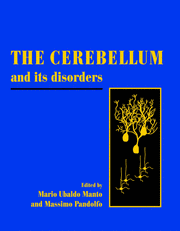Book contents
- Frontmatter
- Contents
- List of contributors
- Preface
- Acknowledgments
- Foreword by Sid Gilman
- PART I INTRODUCTION
- PART II THEORIES OF CEREBELLAR CONTROL
- PART III CLINICAL SIGNS AND PATHOPHYSIOLOGICAL CORRELATIONS
- PART IV SPORADIC DISEASES
- 10 Congenital malformations of the cerebellum and posterior fossa
- 11 Multiple system atrophy and idiopathic late-onset cerebellar ataxia
- 12 Corticobasal degeneration
- 13 Cerebellar stroke
- 14 Immune diseases
- 15 Infectious diseases: radiology and treatment of cerebellar abscesses
- 16 Other infectious diseases
- 17 Cerebellar disorders in cancer
- 18 Posterior fossa trauma
- 19 Thyroid hormone and cerebellar development
- 20 Endocrine disorders: clinical aspects
- PART V TOXIC AGENTS
- PART VI ADVANCES IN GRAFTS
- PART VII NEUROPATHOLOGY
- PART VIII DOMINANTLY INHERITED PROGRESSIVE ATAXIAS
- PART IX RECESSIVE ATAXIAS
- Index
12 - Corticobasal degeneration
from PART IV - SPORADIC DISEASES
Published online by Cambridge University Press: 06 July 2010
- Frontmatter
- Contents
- List of contributors
- Preface
- Acknowledgments
- Foreword by Sid Gilman
- PART I INTRODUCTION
- PART II THEORIES OF CEREBELLAR CONTROL
- PART III CLINICAL SIGNS AND PATHOPHYSIOLOGICAL CORRELATIONS
- PART IV SPORADIC DISEASES
- 10 Congenital malformations of the cerebellum and posterior fossa
- 11 Multiple system atrophy and idiopathic late-onset cerebellar ataxia
- 12 Corticobasal degeneration
- 13 Cerebellar stroke
- 14 Immune diseases
- 15 Infectious diseases: radiology and treatment of cerebellar abscesses
- 16 Other infectious diseases
- 17 Cerebellar disorders in cancer
- 18 Posterior fossa trauma
- 19 Thyroid hormone and cerebellar development
- 20 Endocrine disorders: clinical aspects
- PART V TOXIC AGENTS
- PART VI ADVANCES IN GRAFTS
- PART VII NEUROPATHOLOGY
- PART VIII DOMINANTLY INHERITED PROGRESSIVE ATAXIAS
- PART IX RECESSIVE ATAXIAS
- Index
Summary
Introduction
Corticobasal degeneration (CBD), also called corticobasal ganglionic degeneration (CBGD), was first described by Rebeiz et al. (1967, 1968). It is a slowly progressive, sporadic disease, usually appearing after the age of 50 and affecting both sexes equally (Rinne et al., 1994). CBD is now classified in the group of tauopathies, due to inclusions related to abnormally phosphorylated protein tau (Tolnay and Probst, 1999).
Clinical features
The main clinical features are given in Table 12.1. In the series of Rinne et al., 20 patients over the age of 36 presented with complaints related to a jerky, stiff or clumsy upper limb (Rinne et al., 1994). Similar symptoms related to gait occurred in ten patients. In most of the cases, patients exhibit an asymmetric akinetic-rigid syndrome. Cortical signs are often associated: apraxia, cortical sensory loss, dysphasia, and pyramidal signs. In addition, a dystonic posture of the hand occurs in the majority of patients. ‘Alien hand’ is a sign suggestive of CBD (Doody and Jankovic, 1992). It includes failure to recognize ownership of one's limb when visual cues are removed, a feeling that part of the body is foreign, and autonomous activity perceived as independent of voluntary control (Doody and Jankovic, 1992). Myoclonus is often focal and stimulus sensitive at the beginning of the disease (Chen et al., 1992). Neuropsychiatric disturbances are more frequent than previously thought, including depression, apathy, irritability, and agitation (Litvan et al., 1998).
- Type
- Chapter
- Information
- The Cerebellum and its Disorders , pp. 198 - 201Publisher: Cambridge University PressPrint publication year: 2001

